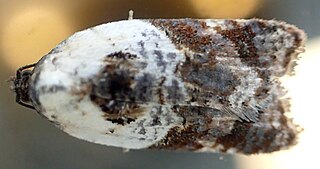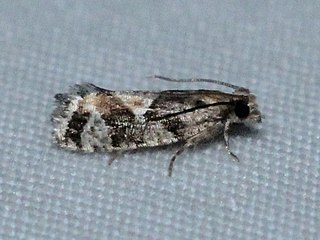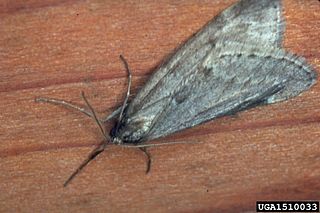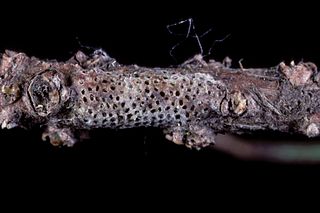
The Tortricidae are a family of moths, commonly known as tortrix moths or leafroller moths, in the order Lepidoptera. This large family has over 11,000 species described, and is the sole member of the superfamily Tortricoidea, although the genus Heliocosma is sometimes placed within this superfamily. Many of these are economically important pests. Olethreutidae is a junior synonym. The typical resting posture is with the wings folded back, producing a rather rounded profile.

The winter moth is a moth of the family Geometridae. It is an abundant species in Europe and the Near East and a famous study organism for evaluating insect population dynamics. It is one of very few lepidopterans of temperate regions in which adults are active in late autumn and early winter. The adults use endothermy for movement in these cold temperatures. The females of this species are virtually wingless and cannot fly, but the males are fully winged and fly strongly. After the initial frosts of late fall, the females emerge from their pupae, walk to and up trees and emit pheromones in the evening to attract males. After fertilization, they ascend to lay, on average, around 100 eggs each. Typically, the larger the female moth is, the more eggs she lays.

The brown-tail moth is a moth of the family Erebidae. It is native to Europe, neighboring countries in Asia, and the north coast of Africa. Descriptions of outbreaks, i.e., large population increases of several years duration, have been reported as far back as the 1500s. The life cycle of the moth is atypical, in that it spends approximately nine months as larvae (caterpillars), leaving about one month each for pupae, imagos and eggs. Larvae (caterpillars) are covered in hairs. Two red spots on the back, toward the tail, distinguish these species from other similarly hairy moth larvae. The winged adults have white wings and a hairy white body with a tuft of brown hair at the tip of the abdomen. Females lay one egg cluster, usually on the underside of a leaf of a host plant. The species is polyphagous, meaning that it feeds on many different species of trees, including pear, apple, maple and oak.

Quercus coccinea, the scarlet oak, is a deciduous tree in the red oak section Lobatae of the genus Quercus, in the family Fagaceae.

The light brown apple moth is a leafroller moth belonging to the lepidopteran family Tortricidae.

Dryocampa rubicunda, the rosy maple moth, is a small North American moth in the family Saturniidae, also known as the great silk moths. It was first described by Johan Christian Fabricius in 1793. The species is known for its wooly body and pink and yellow coloration, which varies from cream or white to bright pink or yellow. Males have bushier antennae than females, which allow them to sense female pheromones for mating.

The green oak tortrix, Tortrix viridana, also known as the European oak leafroller and the green oak moth is a distinctive green moth whose larvae feed on tree leaves, especially oak. The head, forebody and front wings are green, the hind wings lightly greyish. The wingspan is 18-24 millimetres.

Birch leafminers are sawflies, which are closely related to bees and wasps. They are among the most common insect pests affecting birch trees in North America. The primary species affecting birch trees in North America are Profenusa thomsoni and Fenusa pumila. Areas inside the leaves are consumed by the larvae, affecting the leaves' ability to produce food. Yearly browning of birch leaves are noticed in mid July and August, but the leafminers have been feeding inside the leaf tissue since early spring.

Hyblaea puera, the teak defoliator, is a moth and cryptic species complex native to South Asia and South-east Asia. It was first described by Pieter Cramer in 1777. The species has also been recently reported to be present in Central America and Africa. The caterpillar feeds on teak and other trees. It is considered to be one of the major teak pests around the world.

Acleris variegana, the garden rose tortricid moth or fruit tortricid, is a moth of the family Tortricidae. It has a Palearctic distribution. The moth flies from July to September mainly at night and is attracted to bright lights. The larvae feed on various trees and shrubs including rose and apple.

Zeiraphera canadensis, the spruce bud moth, is a moth of the family Tortricidae. It is a small brown moth mainly found in North America, specifically New Brunswick, Quebec, and the north-eastern United States. The adult moth flutters quickly, and stays low among trees during the day and higher above tree cover after sunset. The spruce bud moth relies primarily on the white spruce tree as a host plant. Both male and female spruce bud moths mate multiply, however males have the ability to secrete accessory gland proteins that prevent female re-mating. The moth is univoltine, meaning only one generation hatches per year, and its eggs overwinter from July to May. The species Z. ratzeburgiana is very similar to Z. canadensis and can only be distinguished by the presence of an anal comb in Z. canadensis.

Archips semiferanus is a species of moth in the family Tortricidae, and one of several species of moth commonly known as oak leafroller or oak leaf roller. The larvae feed on the leaves of oak trees in the eastern United States and southeastern Canada and are a major defoliator of oak trees, which can lead to tree mortality. In Pennsylvania in the late 1960s and early 1970s, oak leafrollers defoliated over 1,045,000 acres (423,000 ha).

Acleris is a genus of moths belonging to the subfamily Tortricinae of the family Tortricidae. As of 2007, about 241 species were known.

Alsophila pometaria, the fall cankerworm, is a moth of the family Geometridae. It is found in North America from Nova Scotia west to Alberta, south to Colorado and California and zones of Spain

Anisota virginiensis, the pink-striped oakworm moth, is a species of silk moth of the family Saturniidae.

The gypsy moth, also known as the spongy moth, was introduced in 1868 into the United States by Étienne Léopold Trouvelot, a French scientist living in Medford, Massachusetts. Because native silk-spinning caterpillars were susceptible to disease, Trouvelot imported the species in order to breed a more resistant hybrid species. Some of the moths escaped, found suitable habitat, and began breeding. The gypsy moth is now a major pest of hardwood trees in the Eastern United States.

Archips goyerana, the baldcypress leafroller, is a moth of the family Tortricidae.

Lymantria dispar dispar, commonly known as the gypsy moth, European gypsy moth, LDD moth, or North American gypsy moth or spongy moth, is a species of moth in the family Erebidae. It has a native range that extends over Europe and parts of Africa, and is an invasive species in North America.

Acleris chalybeana, the lesser maple leafroller moth, is a species of moth of the family Tortricidae. It is found in North America, where it has been recorded from Arkansas, Connecticut, Florida, Illinois, Indiana, Kentucky, Maine, Maryland, Mississippi, New Hampshire, New Jersey, New York, North Carolina, Ohio, Ontario, Pennsylvania, Quebec, South Carolina, Tennessee, West Virginia and Wisconsin.
Tomostethus multicinctus, the brownheaded ash sawfly, is a species of sawfly in the family Tenthredinidae that is native to southern Canada and the eastern United States. Adults of this species resemble wasps and the larvae feed on the leaves of ash trees.























